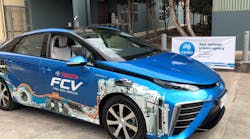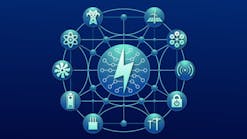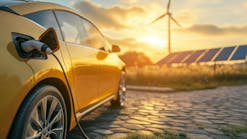We’re all in love in with hydrogen-powered cars and trucks. They’re good for the environment (emitting only water vapor), quiet and appealing to a broad segment of the population.
Both Toyota and Hyundai are reported to be investing millions of dollars in the development of hydrogen-powered cars. The main advantage of hydrogen over electric cars is that they can be filled up in roughly three minutes, like a regular car, and have a range of up to 500 miles.
But there is one hurdle. Where do you find a refuelling station, and how do you get the hydrogen there?
There are two parts to solving the refuelling problem. The first is funding for the infrastructure so that drivers have refuelling stations every couple of hundred miles.
The second is supplying the hydrogen, which is notoriously difficult to transport because of its low density. But hydrogen can be injected into a ‘carrier fuel’, like ammonia, for more straightforward transport and storage. The benefit of this is that ammonia is already in high use around the world and much of the infrastructure is in place.
The Commonwealth Scientific and Industrial Research Organization (CSIRO) researchers have found a way to extract hydrogen from ammonia, meaning it could be shipped safely to mass markets around the world. First announced this past August, scientists at CSIRO, Australia’s pre-eminent national science organization, have created a metal membrane that filters out pure hydrogen gas from ammonia. This enables the hydrogen to be easily dispensed into fuel cell cars, buses and even trucks. This could drive, no pun intended, a new industry to rival the success of the liquefied natural gas (LNG) market.
While the majority of hydrogen (and ammonia) is currently made from coal and natural gas, there is a major opportunity for a renewable hydrogen production industry, especially for countries that have vast solar potential like the United States and Australia. This means that renewable energy could be exported in the same manner as fossil fuel resources have been for decades.
Australia is stepping up to be one of the first countries to create this industry. Japan, Germany and the United States are not far behind. Japan and Germany have the largest number of hydrogen refuelling stations and California has the largest number of hydrogen-fueled cars on the road. Industry experts estimate there could be one million hydrogen-powered cars operational worldwide by 2025.
This innovative technology was commercialized in partnership with Fortescue Metals Group Ltd, one of the largest, global iron ore producers. The investment in CSIRO's hydrogen membrane technology will help companies and countries to develop a hydrogen industry, with the potential for future global uptake.
CSIRO chief executive Dr. Larry Marshall was excited by the prospect of a growing global market for clean hydrogen, and the potential for a national renewable hydrogen export industry. "This is a watershed moment for energy, and we look forward to applying CSIRO innovation to enable this exciting, renewably sourced fuel and energy storage medium a smoother path to market," Marshall said.


